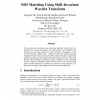Free Online Productivity Tools
i2Speak
i2Symbol
i2OCR
iTex2Img
iWeb2Print
iWeb2Shot
i2Type
iPdf2Split
iPdf2Merge
i2Bopomofo
i2Arabic
i2Style
i2Image
i2PDF
iLatex2Rtf
Sci2ools
BMVC
2001
2001
SSD Matching Using Shift-Invariant Wavelet Transform
The conventional area-based stereo matching algorithm suffers from two problems, the windowing problem and computational cost. Multiple scale analysis has long been adopted in vision research. Investigation of the wavelet transform suggests that -- dilated wavelet basis functions provide changeable window areas associated with the signal frequency components and hierarchically represent signals with multiresolution structure. This paper discusses the advantages of applying wavelet transforms to stereo matching and the weakness of Mallat’s multiresolution analysis. The shift-invariant dyadic wavelet transform is exploited to compute an image disparity map. Experimental results with synthesised and real images are presented.
BMVC 2001 | Computer Vision | Dyadic Wavelet Transform | Wavelet Basis Functions | Wavelet Transform |
Related Content
| Added | 30 Sep 2010 |
| Updated | 30 Sep 2010 |
| Type | Conference |
| Year | 2001 |
| Where | BMVC |
| Authors | Fangmin Shi, Neil Rothwell Hughes, Geoff Roberts |
Comments (0)

